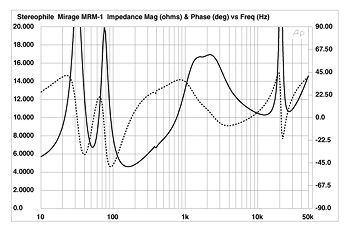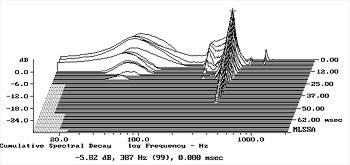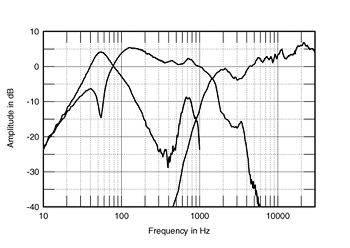| Columns Retired Columns & Blogs |
Mirage MRM-1 loudspeaker Measurements
Sidebar 3: Measurements
The MRM-1's designers apparently chose to optimize the design for bass extension, which means that its sensitivity will be low. I estimated 2.83V to raise just 83dB(B) at 1m, which is about 4dB lower than average. However, the speaker's impedance curve (fig.1) is relatively benign, dropping below 6 ohms only in the lower midrange. The saddle at 52Hz in the magnitude trace indicates the tuning of the reflex port, which in turn implies quite good bass extension. I assume the impedance peak at 21kHz is due to a notch filter used to kill the tweeter's ultrasonic resonance.

Fig.1 Mirage MRM-1, electrical impedance (solid) and phase (dashed). (2 ohms/vertical div.)
The wrinkle in both traces just below 400Hz is presumably due to a cabinet resonance of some kind. Fig.2 shows a cumulative spectral-decay plot calculated from the output of a plastic-tape accelerometer attached to the center of a sidewall. A single resonant mode can be seen at 387Hz, which may well be high enough in both frequency and Q not to affect sound quality. I could certainly hear this mode with a stethoscope and a sinewave sweep. I could also hear it as an added hollowness on the 315Hz and 400Hz 1/3-octave tones on Stereophile's Test CD 3, but it did not otherwise make its presence known on music.

Fig.2 Mirage MRM-1, cumulative spectral-decay plot calculated from the output of an accelerometer fastened to the cabinet sidewall. (MLS driving voltage to speaker, 7.55V; measurement bandwidth, 2kHz.)
Fig.3 shows the individual outputs of the tweeter, woofer, and port. The latter is the bandpass curve centered between 50Hz and 60Hz and coincident with the woofer's minimum-motion point at 52Hz, as expected from the impedance plot. There is a broad peak apparent in the port output at 700Hz, but the audibility of this will be minimized by the fact that the port is on the rear panel. The woofer peaks a little in the upper bass, and crosses over to the tweeter at a low 1.5kHz. A 3.5kHz mode in the woofer's output is well-suppressed by the crossover. The tweeter suffers from a slight lack of presence-region energy, but then rises steadily on-axis in its top two octaves.

Fig.3 Mirage MRM-1, acoustic crossover on-axis at 50", corrected for microphone response, with the nearfield woofer and port responses plotted below 300Hz.
- Log in or register to post comments




































